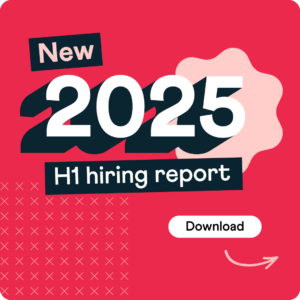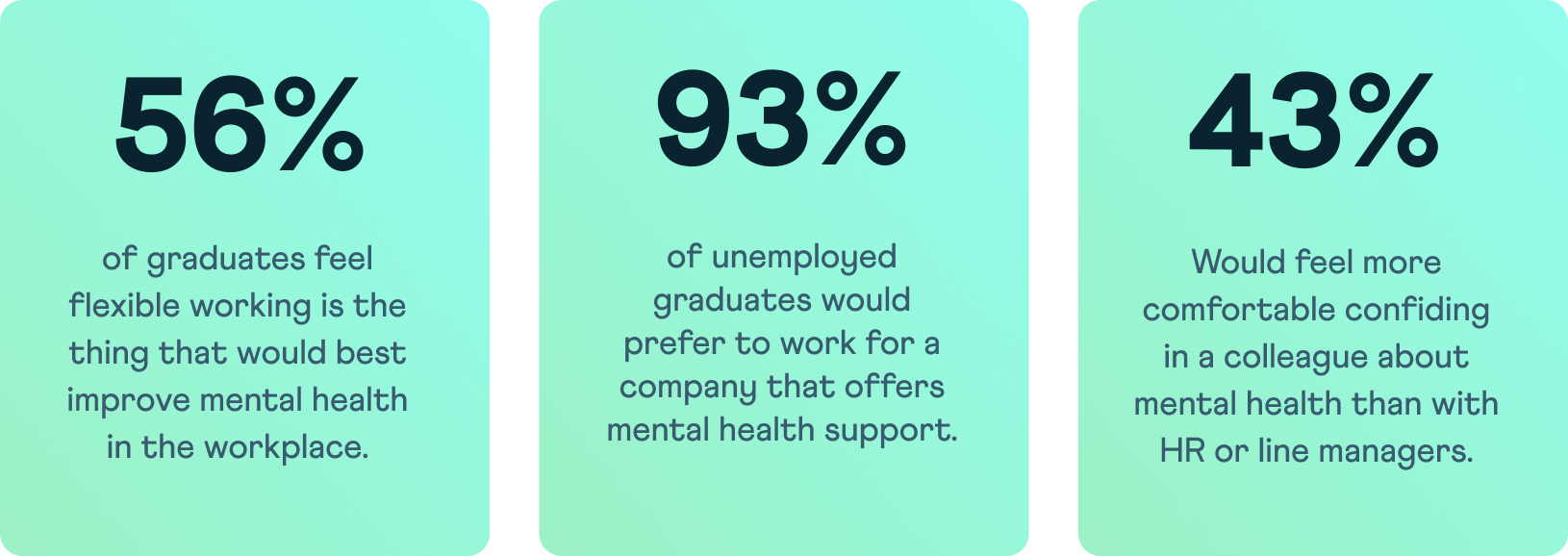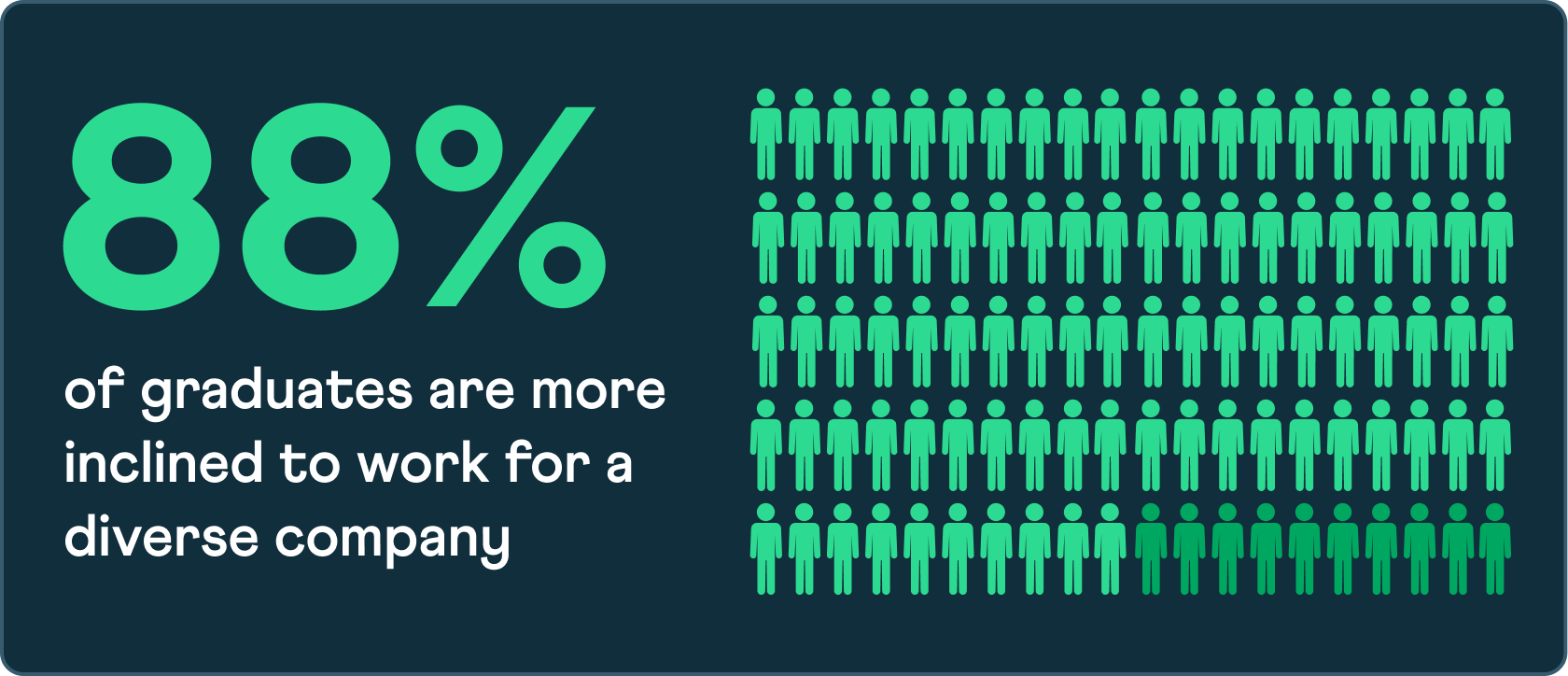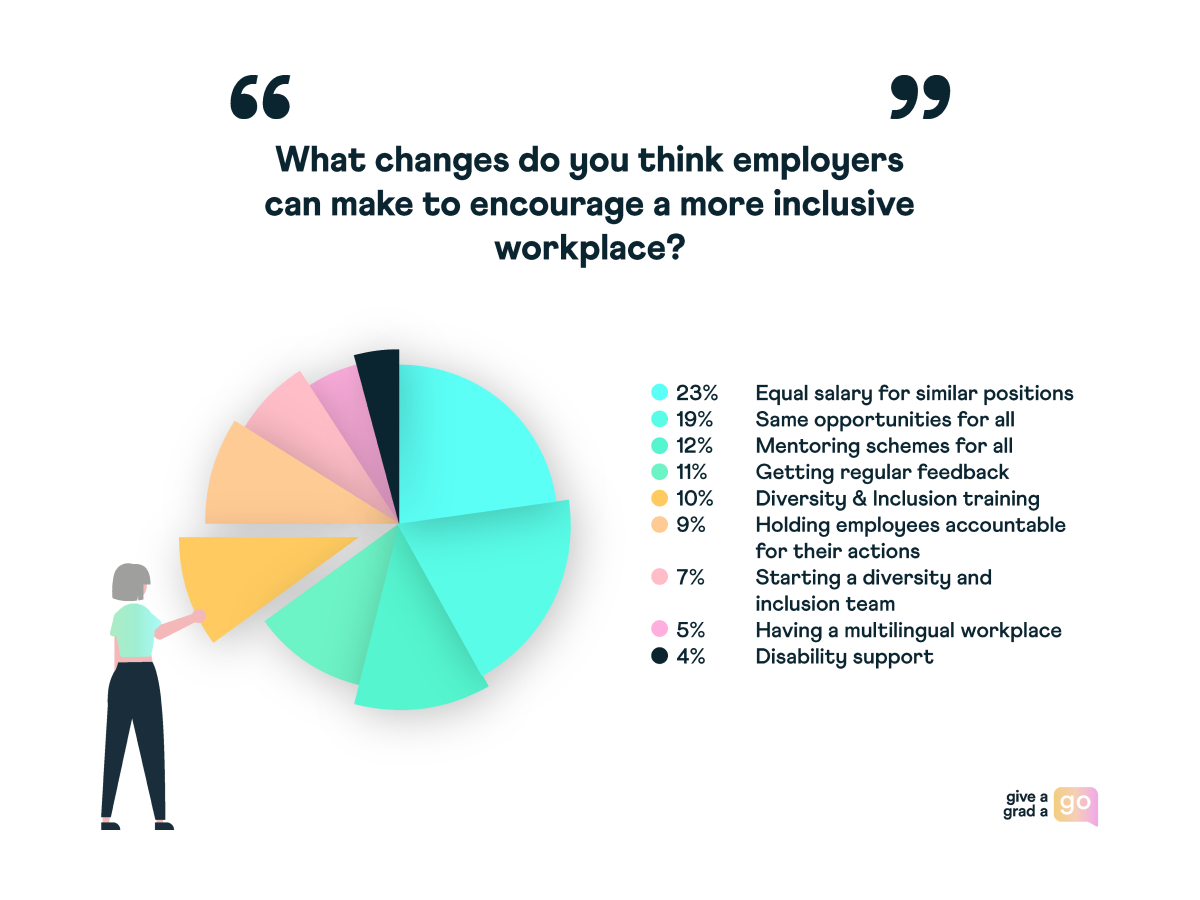Graduate employment statistics
Recruitment trends from
industry experts.
Looking for our Australian site?

We know the graduate market inside-out.
Our database contains 600k+ graduates and a wide array of businesses. This lets us identify new recruitment trends from the frontline
You can stay up-to-date with our bi-annual reports.

79% of graduates are more likely to apply for a role that shows a salary.
Our salary survey showed that graduates prefer transparency from companies.
85% of grads are more likely to apply for jobs offering remote or hybrid working.
The shift towards remote work (and hiring) has been one of the major trends in recruitment this decade.
75% of graduates prefer face-to-face interviews over virtual.
However, jobseekers still value the opportunity to meet their potential employers face-to-face.
93% of graduates expect to receive interview feedback if rejected.
Interview follow-ups are a key stage of the candidate engagement process.
Our latest findings in recruitment and selection reflect the demands of a generation who are prioritising their wellbeing.

Grads voted their top company perk as lunchtime exercise classes or gym memberships
A new hiring trend we’re seeing is graduates prioritising their wellness in the job hunt.

What recruitment trends are emerging in the DEI space?

Almost 30% of grad job seekers have felt overlooked for roles due to discrimination.

* Data in the pie chart shown has been gathered from over 1000 participants.
One of the most prominent emerging trends of recruitment is the rise in sustainability awareness amongst job seekers.
Our past graduate market analysis provides useful data collection and valuable insight into the graduate recruitment industry throughout the years.
Browse the archive below for a breakdown of average salaries, and to see how the graduate recruitment sector has changed since 2015.
We’ve learned over many years that it’s important to stay ahead of the curve.
To recruit at the most effective and competitive rates, it’s crucial to know the ins and outs of the recruitment industry.
For example, if you identify an increased demand for remote working options, offering this as a job benefit is likely to increase applications.
There are always new ideas in jobs and recruitment, and it’s impossible to stay on top of them all.
The best you can do is research the most pertinent patterns and think about ways that you can fit them into your own business strategy.
If you’re a FinTech firm, for instance, it’s best to focus on employment trends in financial services alongside trends in IT recruitment.
Our statistics are well-researched and detailed and they come directly from our own recruitment.
They’re an invaluable insight into the graduate employment market.
Even if you find out that you’re already working in line with emerging resourcing patterns, it’s always good to know that you’re doing things right!
Keeping up with trends in graduate recruitment involves a mix of research, networking, and staying updated with industry publications and reports from the likes of Give a Grad a Go.
With our consistent reports, we’re quick to report on trending shifts in recruitment from our unique vantage.
As one of the UK’s leading graduate recruitment services, we are well-positioned to give sector-specific insights into the graduate hiring space.
With 500k+ candidates registered to our platform, we’re able to gather data and survey feedback from an incredibly large talent pool.
Where better to find out about movements in the recruitment industry than a company at the frontline of graduate recruitment?
Download our graduate job statistics UK report to find expert insight.
There are lots of trends getting noticed in the graduate employment space at the moment.
One is the rising concern for employee satisfaction. Recently, companies have instilled an extremely important (and arguably quite overdue) focus on employee experience in the workplace.
With the rise of flexible and hybrid working, businesses are understanding the significance of these factors in securing and retaining the best talent. In such a talent-led market, it is hard to keep hold of your best employees.
Acknowledging the value that employees place on hybrid working models is, for many, the key to realising a robust employee retention strategy.
Download our documents, and bolster your talent acquisition with expertise.
The latest figures in recruitment reflect a graduate jobs market that is still recovering from the effects of the pandemic and adapting to the cost of living crisis.
An interesting new trend that has emerged amongst graduate job seekers is the increased desire to stay in a role for a long period of time.
According to our research, over 80% of participants see themselves staying in a graduate role for at least 2 years and 30% expect to stay in the job for 5+ years.
This is why it s important for employers to think early on about where they see graduates progressing.
In terms of what the latest trends actually are, first-round interviews are now undertaken virtually by many companies. It speeds up the recruitment process, increases candidate engagement and improves accessibility.
To find out our latest graduate employment insights, make sure to return to this page for the release of our annual statistics report.
Fully comprehending the implications of new hiring patterns is only possible when you have the context of past trends.
For instance, whilst it’s useful to know what percentage of graduates are unemployed at the present moment, knowing whether employment rates are higher or lower than in past years provides a fuller picture.
In the same vein, statistics are only actionable within wider context. It’s important to know whether something is a popular in the moment, or is here to stay.
The most common graduate jobs one month may not correlate with what we’ve seen across the year, indicating an anomaly rather than a trend.
As a leading voice in graduate recruitment, we’re proud to offer an extensive archive of employment statistics dating back to 2015.
To predict what will take hold of the recruitment industry, you have to review commonalities of past years.
By comparing the graduate labour market statistics 2020 and recruitment industry trends 2021/2 with new trends in recruitment 2023, it’s clear that the demand for remote working is not going to diminish any time soon.
However, with the majority of graduates now favouring a workplace with some variation between autonomy and collaboration, it is fair to predict that a hybrid working environment will become highly attractive to job seekers.
With the cost of living constantly on the incline, it is also fair to make the prediction that employers will need to offer higher salaries to appear competitive in the graduate jobs market.
If you are a startup with a tighter budget, don’t let these predictions concern you. Where we see the best retention at the moment, and likely in the future, is at companies that have invested in training and progression opportunities.
Being able to make predictions about job trends of the future will enable you to get ahead of the curve with your hiring process.
Not sure how to implement meaningful changes into your hiring plans? Get in touch with our team!
All of our UK job statistics reports contain information on graduate salary statistics. We source our salary recruitment stats internally from our D&I salary survey and hiring data.
This enables us to gather insights on recruiting salaries directly from one of the largest UK graduate talent pools.
Looking for an average salary survey? Our UK employment statistics reports cover the average graduate salary by industry. From Finance to Marketing & PR, our bi-annual reports provide information on salary range, average salary and top 3 job functions. Plus, our archive dates back to 2015, so you can spot changes to average salaries and predict new hiring trends.
For qualitative statistics on graduate employment & salaries, check out our D&I survey. We ask: “What changes do you think employers can make to encourage a more inclusive workplace?”
The majority of candidates placed ‘equal salary for similar positions’ as the top answer. If you’re using our salary statistics UK to inform your graduate pay, it’s important to take these D&I insights into account.
Find our salary stats in the reports listed above.
Showing hiring patterns by month often does not provide a complete or meaningful picture of employment UK statistics.
As such, we choose to show bi-annual reporting on recruitment market trends. This enables us to provide you with employment insights by industry, but with a holistic overview of the graduate employment market.
With the ever-evolving nature of the graduate job market, hiring is constantly changing. Our research is UK focused: whilst we can’t comment on global hiring trends, we’ve got interesting national insights for 2023:
In terms of internal stats, such as how many applicants per job we receive or what our average time to hire in the UK is:
These examples are taken from our recruitment statistics UK report. For more detailed hiring stats – includingy industry breakdowns – view our latest graduate employment report for H1 2023 here.
We understand the importance of providing D&I stats to help businesses improve their hiring practices for diversity.
Employers are responsible for ensuring equal opportunity for all individuals. By monitoring hiring bias statistics, businesses can identify potential issues in their hiring practices to avoid discrimination and build a more inclusive workplace.
Key diversity and inclusion job hiring statistics:
In terms of looking at our internal employment statistics by race, 46% of our candidates identify as being from Asian, Black, mixed, or other ethnic backgrounds.
If you want a closer look at stats on diversity, check out our diversity and inclusion survey.
*These statistics are taken from our 2020 D&I survey.